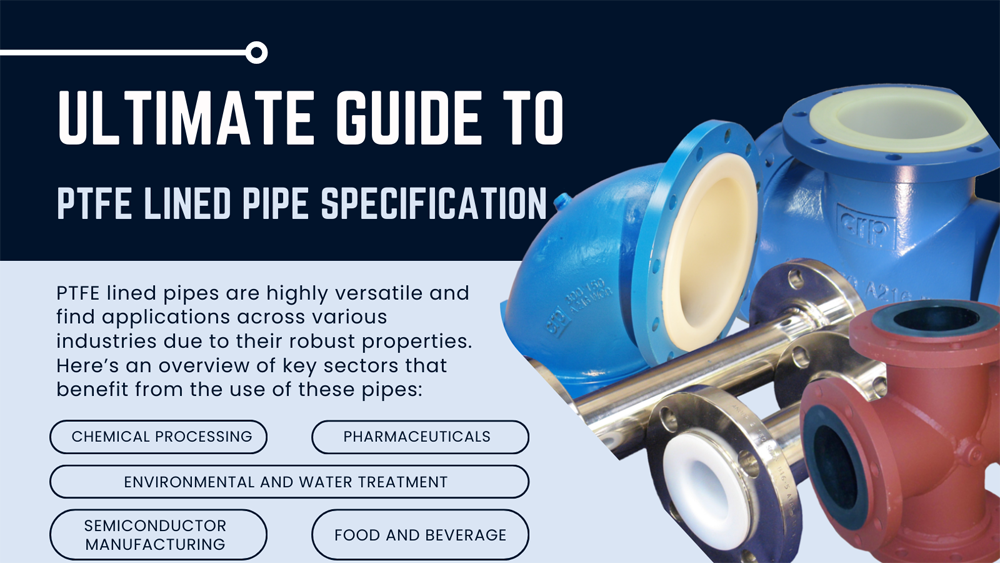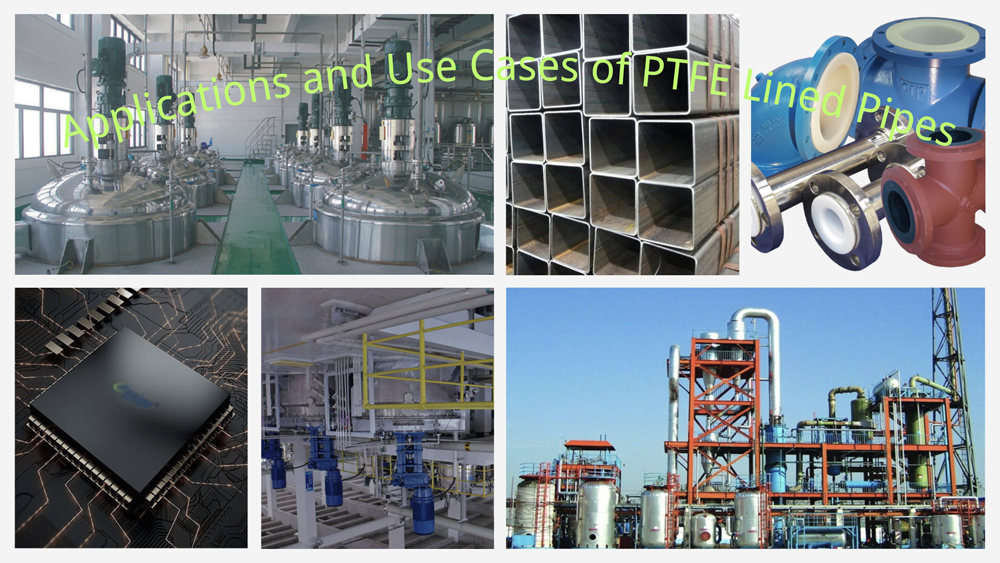
Polytetrafluoroethylene (PTFE), a synthetic fluoropolymer, has been a game-changer in numerous industries, particularly in applications requiring high chemical resistance and thermal stability. PTFE lined pipes, in particular, represent a vital innovation in piping technology, combining the strength of steel pipes with the chemical inertness of PTFE. These pipes are specifically designed to handle corrosive materials at a wide range of temperatures and pressures, making them indispensable in chemical processing, pharmaceuticals, food and beverage production, and more.
The unique properties of PTFE, such as its near-universal chemical resistance, non-stick surface, and ability to withstand temperatures from -260°C to +260°C, make it an ideal choice for lining pipes. These characteristics ensure that processes which involve corrosive liquids and gases can be carried out safely and efficiently. Furthermore, the smooth surface of PTFE reduces friction losses and prevents build-up inside the pipes, which can hinder flow and lead to contamination.
In this guide, we will delve into the specifications of PTFE lined pipes, exploring their key features, installation guidelines, and applications. We’ll also compare PTFE with other lining materials to underscore why PTFE often emerges as the superior choice for many industrial applications. By understanding these specifications and guidelines, industry professionals can make informed decisions about which pipe lining to use for their specific needs.
When selecting PTFE lined pipes for industrial applications, understanding their specifications is crucial for ensuring compatibility with the intended use. These specifications include various dimensions and physical properties that affect performance under different operational conditions.
The thickness of the PTFE lining in pipes typically ranges from 3 mm to 5 mm, providing a robust barrier against corrosive substances. This lining is essential not only for protecting the metal pipe but also for maintaining the purity of the substances flowing through it. The diameter of these pipes can vary widely, generally from 1/2 inch up to 24 inches, accommodating different flow rates and volumes required by various industrial processes.
PTFE lined pipes are renowned for their ability to withstand extreme temperatures. These pipes can operate effectively in environments where temperatures range from as low as -260°C to as high as +260°C. This makes them particularly useful in processes involving hot acids and bases or where steam sterilization is required.
The pressure rating of PTFE lined pipes depends on the core material of the pipe, typically steel or stainless steel, and the design of the pipe itself. Commonly, these pipes are rated for pressures up to 150 psi, making them suitable for a wide range of applications in both low and high-pressure settings.
One of the standout features of PTFE is its exceptional chemical resistance, which enables the lining to withstand almost all types of chemicals. This includes aggressive acids, alkalis, and solvents, ensuring that PTFE lined pipes can be used in a broad spectrum of chemical processes without risk of degradation or contamination.
PTFE lined pipes are manufactured according to various standards to ensure quality and reliability. Common standards include ASTM F1545, which specifies general requirements, materials, dimensions, and workmanship. These certifications are crucial for users to ensure that the products they are purchasing meet rigorous industry standards.
| Specification | Description |
|---|---|
| Thickness | 3 mm to 5 mm, ensuring a durable barrier against corrosive substances. |
| Diameter | Ranges from 1/2 inch to 24 inches to accommodate varying flow rates and volumes. |
| Temperature Ratings | Operational from -260°C to +260°C, suitable for extreme conditions. |
| Pressure Limits | Typically rated up to 150 psi, ideal for both low and high-pressure applications. |
| Chemical Resistance | Resistant to almost all types of chemicals, including aggressive acids, alkalis, and solvents. |
| Standards and Certifications | Commonly adheres to ASTM F1545, ensuring high quality and reliability. |
PTFE lined pipes are highly versatile and find applications across various industries due to their robust properties. Here’s an overview of key sectors that benefit from the use of these pipes:

In the chemical processing industry, the ability to handle highly corrosive substances at varying temperatures is crucial. PTFE lined pipes are extensively used to transport acids, solvents, and other aggressive chemicals without degradation. Their high chemical resistance ensures that the pipes do not react with the materials they carry, thereby maintaining the integrity and purity of the chemicals.
Sterility and non-reactivity are paramount in the pharmaceutical industry. PTFE lined pipes provide a non-stick, inert surface that is ideal for sensitive substances, ensuring that there is no cross-contamination between batches. Their ability to withstand high temperatures also makes them suitable for steam sterilization processes.
The non-toxic and non-reactive nature of PTFE makes these pipes an excellent choice for the food and beverage industry. They help in maintaining taste, quality, and safety standards by preventing any leaching of harmful substances into the product. Additionally, the easy-to-clean surface helps in maintaining strict hygiene standards required in food processing.
The semiconductor industry requires environments free of contaminants. PTFE lined pipes are used to transport gases and chemicals used in the manufacturing process. Their high purity and resistance to extreme conditions make them indispensable in maintaining the controlled environments necessary for semiconductor fabrication.
Water treatment facilities use PTFE lined pipes to handle various chemicals used in water purification processes, including chlorine and other disinfectants. Their corrosion resistance is critical in ensuring long-term durability and effectiveness in such demanding applications.
Proper installation and maintenance are critical to maximizing the lifespan and effectiveness of PTFE lined pipes. Here are some essential guidelines to ensure optimal performance:
Handling: PTFE lined pipes should be handled with care during installation to avoid damaging the lining. Use slings or padded clamps to lift the pipes, rather than hooks or chains that could penetrate the PTFE layer.
Alignment: Ensure that the pipes are correctly aligned before final installation to prevent stress and potential warping of the lining. Misalignment can lead to early wear and tear or even a breach in the lining.
Bolting: When connecting flanged sections, bolts should be tightened in a cross pattern to ensure even distribution of pressure. Over-tightening should be avoided as it can deform the flange and damage the PTFE lining.
Regular Inspection: Schedule regular inspections to check for signs of wear, corrosion, or leakage. Early detection of any issues can prevent more severe problems down the line.
Chemical Cleaning: Use only approved cleaning agents that are compatible with PTFE. Harsh chemicals can degrade the lining, reducing its effectiveness and lifespan.
Avoid Mechanical Damage: Protect pipes from mechanical damage by ensuring they are not exposed to impacts or heavy loads that could crush or puncture the lining.
Maintain detailed records of installation details, maintenance schedules, and any repairs carried out on the pipes. This documentation can help in troubleshooting issues and planning preventive maintenance, ensuring the piping system remains in optimal condition.
These guidelines help ensure that PTFE lined pipes function efficiently and last longer, even in demanding industrial environments.
When choosing the right material for pipe lining, it's crucial to compare PTFE with other commonly used materials to understand its advantages and potential limitations. Here’s a detailed comparison:
Chemical Resistance: PTFE excels in chemical resistance, able to handle a wider range of chemicals at more extreme temperatures than PVC, which can degrade under harsh chemical conditions.
Temperature Tolerance: PTFE can withstand temperatures from -260°C to +260°C, significantly higher than PVC, which has a maximum temperature limit of about 60°C.
Durability: While both materials are durable, PTFE's superior resistance to wear and corrosion makes it a better choice for more demanding industrial applications.
Flexibility: Rubber linings offer more flexibility, which can be beneficial for applications requiring bending and movement. However, PTFE, though less flexible, offers unmatched longevity and stability under chemical exposure.
Cost: Rubber linings are generally less expensive than PTFE but require more frequent replacement, making PTFE a cost-effective option in the long run due to its durability.
Corrosion Resistance: Stainless steel is prone to corrosion in certain environments, whereas PTFE is almost universally chemically inert, providing superior protection against corrosive substances.
Non-stick Surface: PTFE's non-stick properties prevent material build-up inside the pipe, a significant advantage over stainless steel, which can suffer from scaling and clogging.
The use of PTFE lined pipes in various industrial applications offers unparalleled benefits, primarily due to their superior chemical resistance, temperature tolerance, and durability. Throughout this guide, we've explored the essential specifications, applications, installation and maintenance guidelines, and a comparative analysis with other lining materials.
Feel free to leave your message on our board. If you're looking to inquire about prices or place an order, this is the right place! Let us know the details of your needs, and our team will get back to you with a personalized quote as quickly as possible. We're here to ensure your experience is seamless and satisfactory. Share your requirements or ask any questions you might have - we're eager to assist and look forward to doing business with you!
Name:Tim
Phone:+86-15716151880
Email:[email protected]
Company:BEANT
Address:No. 28, Luoshen Road, Luoshe Town, Huishan District, Wuxi City, Jiangsu Province
